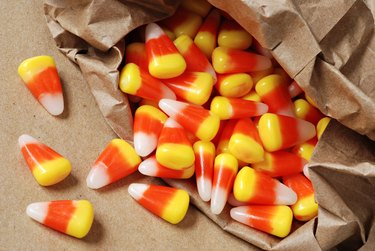
Yellow 5 is also known as tartrazine or E102. Yellow 5 is widely used in the making of potato chips, jams, candy, drinks and even pet food. It is also added to shampoo and other cosmetic products, as well as vitamins and certain medications. Yellow 5 is banned in Austria and Norway, and other European countries have issued warnings about their possible side effects. It is still freely and extensively used in the US, however.
Allergies
Video of the Day
The April 1, 2013 Code of Federal Regulations declare label statements for Yellow 5 must include a warning statement that the color additive may cause allergic reactions, such as asthma. The label can state the low rate of sensitivity related to tartrazine, but must note its prevalence in patients with aspirin hypersensitivity. The strong connection between sensitivity to Yellow 5 and aspirin is presented in multiple studies. A case study published in the June 2006 issue of "Allergology International," reported multiple chemical sensitivities in a 5-year-old girl. Colorful sweets such as candies and jellybeans triggered her symptoms. Researchers discovered the patient had a sensitivity to nonsteroidal anti-inflammatory drugs, such as aspirin, and tartrazine, an azo dye.
Video of the Day
Hyperactivity
Yellow 5 seems to cause hyperactivity in some children. The Food Standards Agency, FSA, which is UK's equivalent to the FDA, issued a warning in 2008 about certain food colorings. The warning said that certain colorings, including tartrazine, can cause behavioral changes in children that included loss of concentration and impulsive, hard-to-control activity. The recommendation is to avoid or limit consumption of products that contain yellow 5. If a child develops hyperactive behavior, try eliminating this coloring from the diet and pay attention to the changes that follow.
Risk of Cancer
In their summary of studies on food dyes, the Center for Science in the Public Interest reports earlier studies that failed to show cancer causing or toxic effects of Yellow 5, were flawed. They did not comply with the minimum FDA standards for the age, number of animal subjects used, and some testing requirements for carcinogenic/chronic toxicity studies. In addition, the industry sponsored studies failed to use maximally tolerated dosages. CSPI determined the FDA limits for the carcinogens benzidine and 4-aminobiphenyl, were inadequately tested. They failed to account for the higher consumption of Yellow 5 by children who are more sensitive to cancer-causing agents. CSPI recommends all carcinogens be removed from food dyes.
Other Risks
The July 2006 issue of the "Journal of Clinical Psychiatry" published a study to determine if allergies to food or to food additives were causing intolerance to psychotropic drugs. Of the 2210 patients given drugs containing tartrazine, 83 developed allergic reactions. None of the study subjects reacted to drugs not containing tartrazine. Researchers determined, in patients exhibiting drug sensitivity, tartrazine allergy should be tested and the medications should be replaced with non-tartrazine-containing drugs. Yellow 5 has been linked to several other health problems, including blurred vision, migraines, fatigue and anxiety. It might also cause chromosomal damage, although this has not been properly studied or documented.